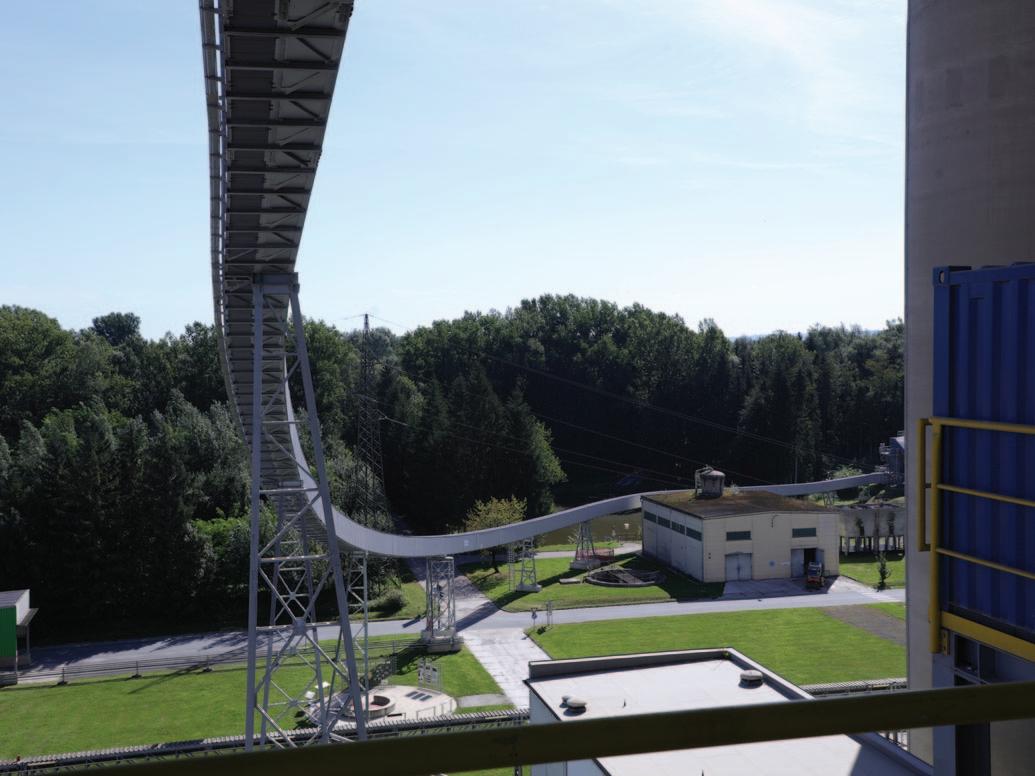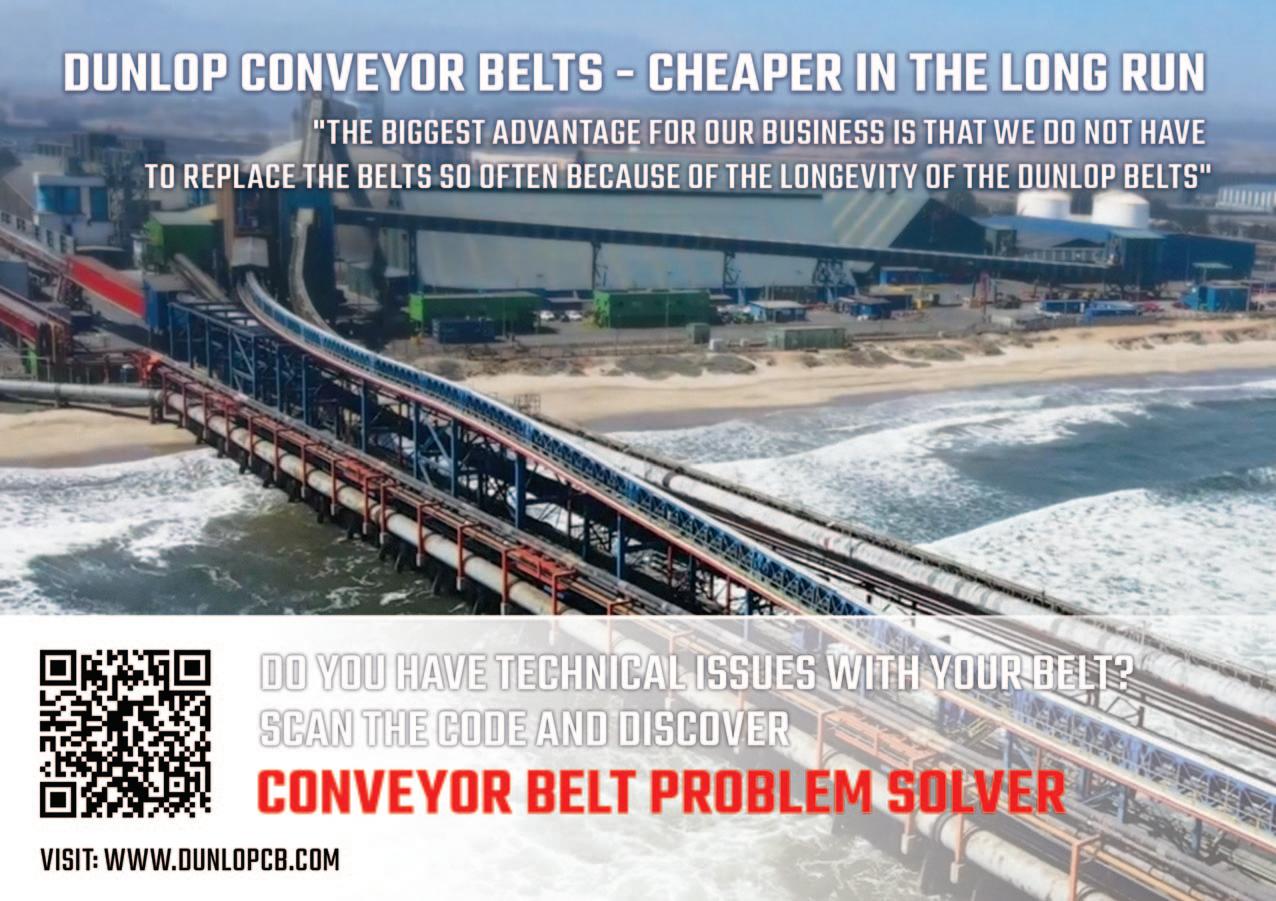
3 minute read
BEUMER Group: the ideal conveying solution
The U-shape conveyor is able to cope with tighter curves than a troughed conveyor and transport larger mass flows than a pipe conveyor (all pictures BEUMER Group GmbH & Co. KG).
How can mining companies make their operations more sustainable in order to reduce their environmental footprint? One adjusting screw is the efficient transport of the mining material to the port, for example. Overland conveyors that can move large quantities of material over long distances are required. The BEUMER Group offers a very suitable conveying solution.
Belt conveyors can be used to transport various bulk materials from and to the port. BEUMER Group supplies a variety of solutions depending on the intended use. Troughed belt conveyors, for example, permit high mass flows. They have an open design and are therefore suitable for coarse materials and very large volumes. Pipe conveyors, by contrast, have other specific advantages. The idlers shape the belt into a closed tube. This protects the transported material against external influences and also protects the environment against emissions such as dust or material loss. Panels with hexagonal cutouts and idler rollers in an offset arrangement keep the tube closed. Pipe conveyors are able to cope with tighter curves and larger angles of inclination than are possible with an open troughed belt conveyor. Their enclosed design also enables them to handle various bulk materials securely without any danger of cross-contamination. They also protect the health of the people who work at the facility or live nearby — for example, when bulk metal concentrates are being transported.
Lukas Paul, Head of Ports & Terminals at BEUMER Group remembers a project in Peru. To transport zinc, copper or lead concentrates mined by a number of different companies from the store to the terminal, the system provider installed a pipe conveyor measuring approximately 3,000 metres in length which transported more than 2,000 tonnes of this material per hour. However, there was a problem: the route passed through a military area with barracks for troops. The enclosed conveyor system reliably prevents the concentrates from coming into contact with the environment and conveys them to the ship’s holds without generating dust. The pipe conveyor is also equipped with filters, scrapers, a dust removal mechanism and a control system, making the need for any transfer points superfluous. “Our belt conveyor systems are an economical and environmentally friendly alternative to truck transport,” says Paul. “They allow operators to automate their processes and remove the burden of the manual work from their employees. This solution also reduces energy consumption.”

Adapting For Improved Performance

Sometimes the bottleneck can be a transfer chute. The facilities are already designed to cope with large volumes of bulk materials, but the transfer chutes through which the material moves from one conveyor to the next are not. “That was true of one of our customers,” reports Paul. In this case, the experts at BEUMER were able to perform a DEM analysis which enabled them to adapt the chutes and eliminate the bottleneck.
“When we talk to our customers and analyse the processes, we very soon see whether a technical solution to the problem already exists,” says Paul. An example? BEUMER Group supplied the conveyor technology for an iron ore terminal in Malaysia. “We were making a few small changes to improve plant performance when we discovered a new problem related to conveying iron ore in a particular condition,” recalls the BEUMER expert: during the rainy season, the material that is to be transported can sometimes become wet and sticky. In this state, material sticks to the conveyor belt and over time is distributed along the complete conveyor route. There was no suitable solution for keeping the belt clean available on the market. “We had tried a number of different belt scrapers but that didn’t really help,” says Paul. BEUMER’s technical experts developed a prototype that cleans the belt using very-highpressure water. “In this way, we were able to remedy a problem for which there had previously been no solution.”
The U-shape conveyor was developed against a similar background. The challenge was to combine the advantages of open troughed and enclosed pipe conveyors: the transported material had to be protected against outside influences such as wind, rain or snow — while the environment had to be protected against potential escaping material and dust. The solution had to be equally suitable for coarse material as well as very fine material. And all this was made even harder by the sometimes complex routing. “In our U-shape conveyors, a special idler roller configuration forms the belt into a U-shape. This is how the bulk material is transported to the discharge station,” explains Paul. A similar idler roller configuration to that used in troughed conveyors is used to open the belt. In this way, BEUMER Group has extended the possibilities for providing the best bulk material transport solution based on the specific need of the individual project.”

